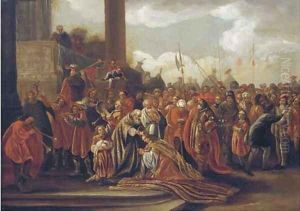Adriaan Verdoel Paintings
Adriaan Verdoel was a Dutch Golden Age painter, born in the year 1620 in Flushing (Vlissingen), a town in the southwestern Netherlands. His artistic journey is somewhat shadowed by the scarcity of surviving records, a common issue for many artists of his era. Despite this, Verdoel managed to carve out a niche for himself within the rich tapestry of 17th-century Dutch art, a period renowned for its incredible depth and diversity of talent.
Verdoel's life and career were deeply intertwined with the cultural and societal shifts of his time. The Dutch Golden Age was a period of unprecedented wealth and artistic production in the Netherlands, fueled by the country's prowess in trade and its burgeoning middle class. This era saw the rise of genre painting, landscapes, and still lifes, as artists moved away from the religious themes that had dominated European art for centuries. Within this vibrant scene, Verdoel developed his style and honed his craft, though the specifics of his training and early influences remain largely speculative.
Historical records indicate that Verdoel's work received some recognition during his lifetime, but he did not achieve the lasting fame of contemporaries like Rembrandt or Vermeer. His oeuvre is believed to have included portraits, landscapes, and religious subjects, reflecting the broad range of interests common among Dutch artists of the period. Despite the relative obscurity of his work today, Verdoel contributed to the rich artistic legacy of the Dutch Golden Age, his paintings capturing the essence of an era that continues to fascinate and inspire.
Adriaan Verdoel passed away in 1675. The exact circumstances of his death, like much of his life, are not well-documented, leaving art historians to piece together his story from the fragments that have survived. While his name may not be as recognizable as some of his peers, Verdoel's work remains a testament to the depth and diversity of talent that defined Dutch art in the 17th century.
